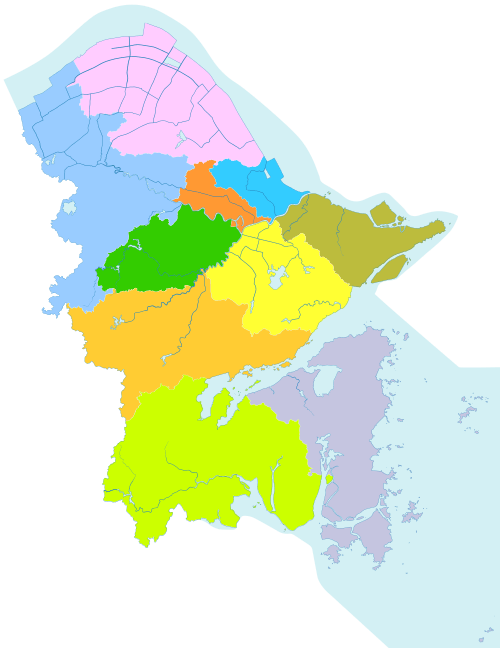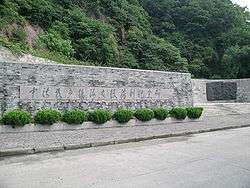Ningbo
Ningbo (Chinese: 宁波; Ningbonese pronunciation: [ɲìɲ.póʔ], Standard Mandarin pronunciation: [nǐŋ pwó] (![]()
Etymology
The first character in the city's name ning (宁 or 寧) means "serene", while its second character bo (波) translates to "wave". The city is abbreviated "甬" (pinyin: Yǒng) for the eponymous "Yong Hill" (甬山), a prominent coastal hill near the city, and the Yong River that flows through Ningbo. (The abbreviation Ning is used more commonly for Nanjing.)
It was once named Mingzhou (明州; Míngzhōu). The first character (明) is composed of two parts, representing two lakes inside the city wall: Sun Lake (日湖) and Moon Lake (月湖). Today, only Moon Lake remains.
History
Ningbo is one of China's oldest cities, with a history dating to the Hemudu culture in 4800 BC. Ningbo was known as a trade city on the silk road at least two thousand years ago, and then as a major port for foreign trade along with Yangzhou and Guangzhou in the Tang Dynasty, and Quanzhou and Guangzhou in the Sung dynasty.
Tang and Song dynasty
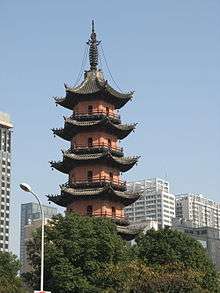
Since the Tang dynasty Ningbo has been an important commercial port. Arab traders lived in Ningbo during the Song dynasty when it was known as Mingzhou,[4] as the ocean-going trade passages took precedence over land trade during this time.[5][6] Another name for Mingzhou/Ningbo was Siming. It was a well known center of ocean-going commerce with the foreign world.[7] These merchants did not intermingle with native Chinese, instead practicing their own customs and religion and inhabiting ghettos. They did not try to proselytize Islam to the Chinese.[8] Jews also lived in Ningbo, as evidenced by the fact that, after a major flood destroyed Torah scrolls in Kaifeng in 1642, a replacement was sent to the Kaifeng Jews by the Ningbo Jewish community.[9]
Ming dynasty
The city of Ningbo was known in Europe for a long time under the name of Liampó. This is the usual spelling used e.g. in the standard Portuguese history, João de Barros's Décadas da Ásia, although Barros explained that Liampó was a Portuguese "corruption" of the more correct Nimpó.[10][11] The spelling Liampó is also attested in the Peregrination (Peregrinação) by Fernão Mendes Pinto, a (so-called) autobiography written in Portuguese during the 16th century. For the mid-16th-century Portuguese, the nearby promontory, which they called the cape of Liampó, after the nearby "illustrious city" was the easternmost known point of the mainland Asia.[10] The Portuguese began trading in Ningbo around 1522. By 1542, the Portuguese had a sizable community in Ningbo (or, more likely, on nearby small islands such as Shuangyu). Portuguese activities from their Ningbo base included pillaging and attacking multiple Chinese port cities around Ningbo for plunder and spoil. They also enslaved people during their raids.[12] The Portuguese were ousted from the Ningbo area in 1548.
Qing dynasty
Ningbo was one of the five Chinese treaty ports opened by the Treaty of Nanjing (signed in 1842) at the end of the First Opium War between Britain and China. During the war, British forces briefly took possession of the walled city of Ningbo after storming the fortified town of Zhenhai at the mouth of the Yong River on October 10, 1841. The British subsequently repulsed a Chinese attempt to retake the city in the Battle of Ningpo on March 10, 1842. In 1861, the forces of the Taiping Rebellion took the city relatively unopposed as the defending garrison fled; they held the town for six months.[13] In March 1885, during the Sino-French War, Admiral Courbet's naval squadron blockaded several Chinese warships in Zhenhai Bay and exchanged fire with the shore defenses.
Ningbo was also once famed for traditional Chinese furniture production. During the Qing dynasty, western encyclopedias described Ningbo as a center of craftsmanship and industry.[14][15]
During the late Qing dynasty, in the 1800s, the Ningbo authorities contracted Cantonese pirates to exterminate and massacre Portuguese pirates who had raided Cantonese shipping around Ningbo. The massacre was "successful", with 40 Portuguese dead and only 2 Chinese dead, being dubbed "The Ningpo Massacre" by an English correspondent, who noted that the Portuguese pirates had behaved savagely towards the Chinese, and that the Portuguese authorities at Macau should have reined in the pirates.
During late Qing era, Western missionaries set up a Presbyterian Church in Ningbo. Li Veng-eing was a Reverend of the Ningpo Church.[16] The Ningpo College was managed by Rev. Robert F. Fitch. The four trustees were natives of Ningbo, three of them had Taotai rank.[17] Rev. George Evans Moule, B. A. was appointed a missionary to China by the Church of England Missionary Society, and arrived at Ningpo with Mrs. Moule in February 1858. He then began a mission station at Hang-chow, between which and Ningpo his time had been chiefly divided. He wrote Christian publications in the Ningbo dialect.[18]
Republican era
During World War II in 1940, Japan bombed Ningbo with ceramic bombs full of fleas carrying the bubonic plague.[19] According to Daniel Barenblatt, Prince Tsuneyoshi Takeda received, with Prince Mikasa, a special screening by Shiro Ishii of a film showing imperial planes loading germ bombs for bubonic dissemination over Ningbo in 1940.[20]
- "It has been said of the Ningbo fishermen that, 'no people in the world apparently made so great an advance in the art of fishing; and for centuries past no people have made so little further progress.'"[21]
Between 80% to 90% of Ningbo's population fled the city during the Japanese invasion.[22]
Geography
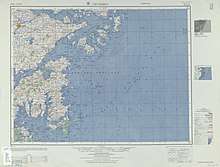
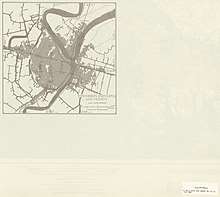
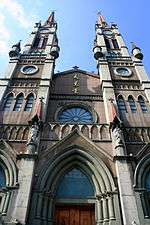
Ningbo ranges in latitude from 28° 51' to 30° 33' N and in longitude from 120° 55' to 122° 16' E, bounded on the east by the East China Sea and Zhoushan Archipelago, on the north by Hangzhou Bay, across which it faces Jiaxing and Shanghai, on the west by Shaoxing, and on the south by Taizhou. Its land area is 9,816 square kilometers (3,790 sq mi), while oceanic territory amounts to 9,758 km2 (3,768 sq mi); there is a total 1,562 km (971 mi) of coastline including 788 km (490 mi) of mainland coastline and 774 km (481 mi) of island coastline, together accounting for one-third of the entire provincial coastline. There are 531 islands accounting for 524 km2 (202 sq mi) under the city's administration.
Ningbo's city proper is sandwiched between the ocean and low-lying mountains to the southwest, with coastal plain and valleys in between. Important peninsulas include the Chuanshan Peninsula (穿山半岛), located in Beilun District and containing mainland Zhejiang's easternmost point, and the Xiangshan Peninsula (象山半岛) in Xiangshan County. The Siming Mountains (四明山) run north from Mount Tiantai and within Ningbo City, traverse Yuyao City, Haishu District, and Fenghua District, reaching a height of 979 m (3,212 ft).
Climate
Ningbo has a humid subtropical climate (Köppen Cfa) with four distinctive seasons, characterized by hot, humid summers and chilly, cloudy and dry winters (with occasional snow). The mean annual temperature is 17.15 °C (62.9 °F), with monthly daily averages ranging from 5.3 °C (41.5 °F) in January to 28.8 °C (83.8 °F) in July. Extremes since 1951 have ranged from −8.8 °C (16 °F) on 12 January 1955 to 42.1 °C (108 °F) on 8 August 2013.[23] The city receives an average annual rainfall of 1,430 mm (56 in) and is affected by the plum rains of the Asian monsoon in June, when average relative humidity also peaks. From August to October, Ningbo experiences the effects of typhoons, and is affected by an average 1.8 storms annually, though the city is not often struck directly by these systems. A 2012 OECD study lists Ningbo among the top 20 cities worldwide most at risk of flooding due to anthropogenic climate change.[24]
| Climate data for Ningbo (Yinzhou District, 1981–2010 normals) | |||||||||||||
|---|---|---|---|---|---|---|---|---|---|---|---|---|---|
| Month | Jan | Feb | Mar | Apr | May | Jun | Jul | Aug | Sep | Oct | Nov | Dec | Year |
| Record high °C (°F) | 24.4 (75.9) |
28.9 (84.0) |
34.0 (93.2) |
34.3 (93.7) |
36.3 (97.3) |
38.0 (100.4) |
39.0 (102.2) |
39.5 (103.1) |
38.8 (101.8) |
34.5 (94.1) |
29.5 (85.1) |
25.0 (77.0) |
39.5 (103.1) |
| Average high °C (°F) | 9.3 (48.7) |
11.0 (51.8) |
14.8 (58.6) |
20.7 (69.3) |
25.6 (78.1) |
28.7 (83.7) |
33.5 (92.3) |
32.6 (90.7) |
28.3 (82.9) |
23.6 (74.5) |
18.2 (64.8) |
12.2 (54.0) |
21.5 (70.8) |
| Daily mean °C (°F) | 5.3 (41.5) |
6.9 (44.4) |
10.4 (50.7) |
15.8 (60.4) |
20.9 (69.6) |
24.5 (76.1) |
28.8 (83.8) |
28.3 (82.9) |
24.4 (75.9) |
19.3 (66.7) |
13.6 (56.5) |
7.6 (45.7) |
17.2 (62.9) |
| Average low °C (°F) | 2.4 (36.3) |
3.8 (38.8) |
7.0 (44.6) |
12.1 (53.8) |
17.3 (63.1) |
21.5 (70.7) |
25.5 (77.9) |
25.3 (77.5) |
21.5 (70.7) |
16.0 (60.8) |
10.2 (50.4) |
4.1 (39.4) |
13.9 (57.0) |
| Record low °C (°F) | −7.9 (17.8) |
−6.2 (20.8) |
−3.7 (25.3) |
0.7 (33.3) |
7.4 (45.3) |
12.7 (54.9) |
18.2 (64.8) |
18.4 (65.1) |
11.0 (51.8) |
1.4 (34.5) |
−3.0 (26.6) |
−8.5 (16.7) |
−8.5 (16.7) |
| Average precipitation mm (inches) | 73.2 (2.88) |
77.6 (3.06) |
133.9 (5.27) |
105.6 (4.16) |
114.6 (4.51) |
198.1 (7.80) |
178.3 (7.02) |
166.7 (6.56) |
170.8 (6.72) |
83.1 (3.27) |
75.0 (2.95) |
54.7 (2.15) |
1,431.6 (56.35) |
| Average precipitation days (≥ 0.1 mm) | 12.6 | 12.3 | 16.9 | 15.3 | 14.7 | 16.4 | 13.1 | 14.5 | 14.1 | 10.3 | 8.9 | 8.5 | 157.6 |
| Average relative humidity (%) | 77 | 77 | 77 | 75 | 76 | 81 | 77 | 79 | 80 | 77 | 76 | 74 | 77 |
| Mean monthly sunshine hours | 123.7 | 108.4 | 121.7 | 142.4 | 156.7 | 147.8 | 243.8 | 238.0 | 171.5 | 166.5 | 143.4 | 146.1 | 1,910 |
| Percent possible sunshine | 38 | 35 | 33 | 37 | 37 | 35 | 57 | 58 | 46 | 47 | 45 | 46 | 43 |
| Average ultraviolet index | 4 | 5 | 7 | 9 | 10 | 11 | 11 | 11 | 9 | 7 | 4 | 3 | 8 |
| Source 1: China Meteorological Administration,[25] China Weather (precipitation days 1971–2000) [26] | |||||||||||||
| Source 2: Ningbo Climate Studies (sunshine)[27]Weather Atlas (uv)[28] | |||||||||||||
Administrative structure
The mayor of Ningbo is Liu Qi. Wang Huizhong is the secretary of CPC in Ningbo, who is first-in-charge of the city. The Communist Party Secretary is always the highest official in cities in China and outranks all other officials.
Ningbo Local Government Offices
The sub-provincial city of Ningbo is as whole an urban group with one central group, one northern group, and one southern group. It has direct jurisdiction over six districts (central group), two county-level cities (northern group) and two counties (southern group):
| Map | ||||||
|---|---|---|---|---|---|---|
| Subdivision | Simplified Chinese | Pinyin | Population (2017) | Area (km2) | Density | |
| Central Urban Districts | ||||||
| Primary urban districts & affiliated rural (Tri-river Area) | ||||||
| Haishu District | 海曙区 | Hǎishǔ Qū | 909,000 | 595.03 | 1,527.65 | |
| Yinzhou District | 鄞州区 | Yínzhōu Qū | 1,294,000 | 799.09 | 1,619.34 | |
| Jiangbei District | 江北区 | Jiangbei Qū | 375,000 | 208.14 | 1,801.67 | |
| Secondary urban districts & affiliated rural | ||||||
| Beilun District | 北仑区 | Běilún Qū | 668,000 | 597.76 | 1,117.51 | |
| Zhenhai District | 镇海区 | Zhènhǎi Qū | 443,000 | 244.28 | 1,813.49 | |
| Fenghua District | 奉化区 | Fènghuà Qū | 511,000 | 1,267.60 | 403.12 | |
| Southern Counties | ||||||
| Xiangshan County | 象山县 | Xiàngshān Xiàn | 526,000 | 1,382.18 | 380.56 | |
| Ninghai County | 宁海县 | Nínghǎi Xiàn | 682,000 | 1,843.26 | 367.00 | |
| Northern Cities | ||||||
| Yuyao | 余姚市 | Yúyáo Shì | 1,095,000 | 1,500.80 | 729.61 | |
| Cixi | 慈溪市 | Cíxī Shì | 1,502,000 | 1,360.63 | 1,103.90 | |
- Defunct: Jiangdong District
Economy
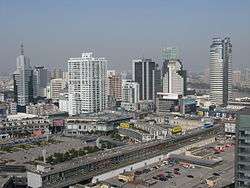
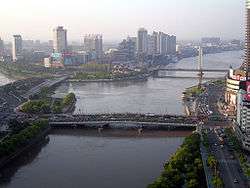
Ningbo is an important port city located 220 kilometers (140 mi) south of Shanghai. The city's export industry dates back to the 7th century. Today, Ningbo is a major exporter of electrical products, textiles, food, and industrial tools. The city's private sector is especially well-developed, contributing 80 percent of total GDP in 2013.[32]
Historically, Ningbo was somewhat geographically isolated from other major cities. In 2007 the Hangzhou Bay Bridge was built, cutting highway transit time between Ningbo and Shanghai from four hours to two and a half. The city now serves as the economic center for the southern Yangtze River Delta and has been ranked among the most competitive cities in China.[32]
In 2009, Ningbo's economic activity reached US$60.8 billion, down 10.4% from 2008. The exports totaled US$38.65 billion, down 16.6% from the previous year. In addition, Ningbo imported US$22.16 billion of goods, up 3.1% from the previous year.[33]
Ningbo's economy grew 9.26 percent in 2013 to 712.89 billion yuan (US$115.12 billion).[32] In 2009, the city's per capita output was US$10,833, about three times the national average.[34]
Ningbo is famous for the Si Lan Nong Xiang flower, which is used for dying cloth. In 2008, Ningbo's cloth exports were responsible for 3% of its economic growth.
Foreign investment
With several important development zones established in or around Ningbo, the city has received considerable foreign investment.[35] Over 60 domestic and foreign-invested financial institutions have established operations in the city, which has also attracted more than 10,000 foreigners. The municipal government offers preferential policies designed to encourage investment in international trade, new strategic industries, manufacturing, information services, and creative industries.[32]
Economic and technological development zones
Ningbo Economic & Technological Development Zone
Located in the north-east of Ningbo, behind Beilun Port, NETD is 27 km (17 mi) away from the city center. With more than 20 years of great effort, NETD has already formed the general framework for large scale construction and development, and established the perfect investment environment. It is situated close to the Ningbo Port and Ningbo Lishe International Airport. Major Investors include Exxon Mobile, Dupont and Dow Chemical.[36]
Ningbo Daxie Development Zone
The Ningbo Daxie Development Zone was approved in 1993 and covers an area of 5.92 km2 (2.29 sq mi). Over more than ten years of development and construction, industrial and logistical foundations have been established in the zone for the transshipment of energy, liquid chemicals and containers.[36]
Ningbo National Hi-Tech Industrial Development Zone
Ningbo National Hi-Tech Industrial Development Zone was founded in 1999 and was upgraded to a national level zone in January 2007. It is 10 km (6.2 mi) from Ningbo International Airport and 18 km (11 mi) away from Ningbo Port. The zone serves as the important technical innovation base of Yangtze River Delta. Industries encouraged include chemicals production and processing, biotechnology and pharmaceuticals, raw material processing, Research and Development.[37]
Ningbo Free Trade Zone
Ningbo Free Trade Zone is one of the 15 free trade zones authorized by the State Council of China, and is the only free trade zone in Zhejiang Province. It was established by State Council in 1992, covering the area of 2.3 km2 (0.89 sq mi). It lies in the middle of the coastline of Mainland China, at the south of Yangtze River Delta. In 2008, its industrial output value was RMB 53.33 billion and grew at 19.8% as compared to 2007.[38]
Nordic Industrial Park
The Nordic Industrial Park Co. Ltd. (NIP) is one of the first wholly foreign-owned industrial parks in China located in Ningbo, Zhejiang Province. NIP is managed and operated by a Scandinavian management team.[39]
Ningbo Advertising Park
The Ningbo Advertising Park is a national level pilot park located in the Ningbo Southern Business District. The financial incentives have attracted over 300 relevant firms to establish operations.[40]
Ningbo Port
Ningbo is not just an ordinary city—it has the same authority as provincial governments for economic administration—and has a port second only to Shanghai around the world in terms of annual cargo throughput. Unlike Shanghai, the port is deep-water and capable of handling 300,000 ton vessels. The port is located mainly in Beilun district and Zhenhai district. In 2006, Ningbo Port started its expansion towards the neighboring island city of Zhoushan for the purpose of building an even larger port with higher capacity to compete with neighboring ports in the region, such as Shanghai's Yangshan Deep-Water Port. The statistics in 2010 showed that total cargo throughput was 627,000,000 tons and container throughput 13,144,000 TEUs. With bulk container breakdowns, hugely improved logistics, and massive chemical and foodstuff, processing developments, Ningbo could win the race against Shanghai for the preeminent Chinese east coast port.[41]
Tourism
- Tianyi Pavilion (Tianyi Ge), one of Ningbo's most popular tourist attractions, is in the vicinity of Moon Lake (Yuehu). Built in 1516 and said to be the oldest surviving library in China, it was founded by Ming official Fan Qin, whose collection went back to the 11th century and included woodblock and handwritten copies of the Confucian classics, rare local histories and lists of the candidates successful in imperial examinations. The library's garden and outhouses contain small displays of old books and tablets.
- The Ningbo Mosque (Chinese: 月湖清真寺;; pinyin: Yuèhú Qīngzhēnsì).[4]
- Baoguo Temple, the oldest intact wooden structure in eastern China, is located in Jiangbei District, 15 km (9.3 mi) north of Ningbo city proper.
- Qita Temple, a Zen Buddhist temple complex first consecrated during the Tang Dynasty.
- Tianhou Temple, a former temple of Mazu as the "Empress of Heaven" once used by Fujianese merchants as their guild hall (Qing'an Huiguan). In the 19th century, it was accounted by S. Wells Williams as the most beautiful place in Ningbo and by John Thomson as one of the most beautiful temples in China, but that structure was destroyed during the Chinese Civil War. It has been reconstructed with many of its original works of art, however, to form the East Zhejiang Maritime Affairs and Folk Customs Museum.
- Tianfeng Pagoda
- Ashoka Temple
- Tiantong Temple
- Tianyi Square
- Yushan Islands
- Dongqian Lake
- Xuedou Temple
- Hemudu Relics
- Jiulong Lake
- Zhaobao Mountain
- Mount Phoenix Theme Park
- Romon U-Park
- Ningbo Museum
Notable people
Many well known Chinese came from Ningbo or have Ningbo as their ancestral home.
- People in mainland China
- Zhang Jianhong, freelance writer, playwright, poet, and also a democracy activist
- Pan Tianshou, an artist in Chinese painting
- Zhou Xinfang, an artist in Peking opera
- Sha Menghai, a master calligrapher
- Tu Youyou, a scientist awarded the Nobel Prize in Physiology or Medicine
- People in Hong Kong
- Run Run Shaw
- Tung Chee Hwa
- Tung Chao Yung
- Chen Din Hwa
- Stephen Chow
- Sammo Hung
- Yue-Kong Pao
- People in Taiwan
- Chiang Kai-shek, political and military leader of 20th century China
- Chiang Ching-kuo, Chiang Kai-shek's son
- Morris Chang
- People overseas
- Shien Biau Woo
- Yo Yo Ma
- Kin Yamei
Transportation
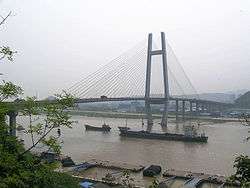
Bridge
As there are three main rivers running through Ningbo, it is crucial to build bridges to improve the efficiency of the transport network in Ningbo. The Ling Bridge which connects Haishu district and Jiangdong District is the earliest modern bridge built in Ningbo, designed by German engineers. Since the late 1980s, 16 bridges have been built on the three rivers. Currently another 27 bridges are under construction.
The Hangzhou Bay Bridge, a combination cable-stayed bridge and causeway across Hangzhou Bay, opened to the public on May 1, 2008. This bridge connects the municipalities of Shanghai and Ningbo, and is considered the longest trans-oceanic bridge in the world. It is the world's second-longest bridge, after the Lake Pontchartrain Causeway in Louisiana, United States.
The Jintang Bridge, a 4 lane sea crossing bridge linking Jintang Island of Zhoushan and Zhenhai district, is a 27 km (17 mi) long opened on December 26, 2009.
The Xiangshan Harbor Bridge opened to traffic on December 29, 2012, connecting Ningbo with Xiangshan. The 47 km (29 mi)long project includes 22 km (14 mi) as the main body of the bridge and a 8 kilometer-long tunnel.[42]
Sea
The port of Ningbo is one of the world's busiest ports. It was ranked number 7 in total Cargo Volume and number 6 in total container traffic in 2011.[43]
Air
Ningbo Lishe International Airport connects Ningbo by air to the rest of China, with regularly scheduled domestic and international flights. In 2009, new air routes between Ningbo and Taiwan were opened. Jetstar Asia launched a new route between Ningbo and Singapore in September 2011. Tiger Air planned to begin flying this route from 26 December 2013.
Railway
Three railway lines intersect in Ningbo: the Xiaoshan–Ningbo Railway (Xiaoyong Line), which runs west to Hangzhou, the Ningbo–Taizhou–Wenzhou (Yongtaiwen) Railway, which runs south to Wenzhou, and the Hangzhou–Ningbo High-Speed Railway, which runs parallel to the Xiaoyong Line providing high-speed railway service.
With the booming economy in the region, the Xiaoyong Railway, a conventional railway built in the 1950s, could not meet the demand for railway travel between Zhejiang's two largest cities, so construction of a new high-speed railway line between Hangzhou and Ningbo started in 2009. The new railway line was finished by 2013 and reduced travel time between Ningbo and Hangzhou to 50 minutes.
The Ningbo–Taizhou–Wenzhou Railway is a high-speed railway that opened in September 2009. It connects Ningbo with cities along the coast to the south to Fujian Province. High-speed trains on this line operate at speeds of up to 250 km/h (160 mph).
Ningbo re-opened the Ningbo railway station after three years of construction on December 28, 2013. With a construction area of more than 120,000 m2,[44] it is one of the largest railway stations in China.
Expressway
Seven expressways connect Ningbo with its surrounding cities:
- The Hangyong expressway, built in the 1990s, connects Hangzhou and Ningbo, now part of Hangzhou Bay ring expressway (G9211).
- The Yongtaiwen expressway (G15), opened in 2000, connects Ningbo with Taizhou and Wenzhou.
- The Yongjin expressway (G1512) connects Ningbo and Jinhua.
- The Huyong expressway (G15) connects Ningbo and Shanghai via the Hangzhou Bay bridge.
- The Yongzhou expressway (G9211) via Jintang Bridge.[45]
- The G1501 Ningbo Ring Expressway
- The G15W2 Ningbo–Dongguan Expressway
Rapid transit
Ningbo has two metro lines in service consisting of Line 1, which is 46.2 kilometers in length and has 29 stations, and Line 2, which is 28.4 kilometers in length and has 22 stations. More lines are under construction. Line 3 is scheduled to be finished in the year 2019 and Line 4 in 2020. Future plans are for 7 metro lines serving Ningbo.
Military
Ningbo is the headquarters of the East Sea Fleet of the Chinese People's Liberation Army Navy. Its responsibility includes projecting force in the region around the Republic of China (Taiwan), which the People's Republic of China views as a renegade province.
Culture
As a city with giant ports, Ningbo influenced many countries near China, such as Japan.
Language
Ningbo speech is a dialect of Wu Chinese that has preserved many aspects of ancient Chinese phonology. Its original wording mode can be found in classical reference books. It can be found that the trisyllable and tetrasyllable phrases or proverbs in Ningbo dialect make it most unusual and dynamic. Moreover, the onomatopoeia, assonance words, collocations, inversions, and other language characteristics within Ningbo dialect all add spice to people's life. After the unequal treaty port opening, western culture gradually permeated Ningbo. Thus the prefix "洋 yang" before the nouns of imported goods is a special language phenomenon of Ningbo dialect.[46]
Food
Ningbo is known for Ningbo Tangyuan, small stuffed buns which are boiled. The stuffing is usually ground sesame mixed with sugar. It can also be mixed with pork fat. The stuffing is wrapped with sticky rice powder. Even more so, Ningbo is famous throughout China for its seafood. Seafood markets are abundant, carrying countless varieties of fish, crabs/lobsters/shrimp, shellfish, snails, jellyfish and other invertebrates, and sea vegetables in all stages of preparation from "still swimming," to cleaned and ready to cook, to fully cooked.
Festivals
Ningbo has many traditional Han Chinese festivals same as other provinces in China. However, the date of Mid-Autumn Festival is different from others. Han Chinese will have Mid-Autumn Festival on Lunar Calendar August 15, but Ningbo will have on August 16th. The most creditable history for this is that long ago, the whole city waited for Shih Hao, a Southern Sung prime minister.
Education
By the end of 2013, there were 2,097 schools of all levels in total, with 1,334,000 students. Among them there are 16 colleges and universities, with 153,000 students; 81 secondary schools, with 97,000 students; 55 vocational schools, with 78,000 students; 216 junior schools, with 189,000 students; 465 primary schools, with 487,000 students; 1,254 kindergartens, with 276,000 children. Besides, there are 2,500 international students in universities in Ningbo, up 56% from last year. All talents in Ningbo increased by 112,000 people (8.6%) in 2013, and the total amount came to 1,413,000.[47]
By the end of 2014, there were 2,082 schools of all levels in total, with 1,320,700 students. Among them there are 14 colleges and universities, with 150,900 students; 83 secondary schools, with 90,300 students; 52 vocational schools, with 72,8000 students; 209 junior schools, with 189,8000 students; 457 primary schools, with 482,600 students; 1,254 kindergartens, with 278,400 children.[48]
Universities and colleges
Ningbo has 16 colleges and universities. University of Nottingham Ningbo China is China's very first Sino-Foreign University – a joint venture between the University of Nottingham and the Wanli Education Group. UNNC has built a very high reputation in China for the quality of its undergraduate education and graduated its first PhD students in 2013.[49] Toward the north of the city is Ningbo University, while the Ningbo Higher Education Zone (Yinzhou district) is home to Zhejiang Wanli University, affiliated to Zhejiang University, Ningbo Institute of Technology, Zhejiang University, which was ranked as the eleventh best of independent colleges in China in 2011,[50] is also in this education zone.
Secondary and primary education
Compulsory education (basic education in Chinese terms) is from the ages 6 to 15. Students are catered to in a variety of state and private schools. Studying for the gaokao(高考), a test of a student's skill, is optional.[51]
International education
Several schools are permitted to operate foreign educational programs as an alternative to the Chinese National curriculum and accept international students.
Access International Academy Ningbo (AIAN) and Ningbo Zhicheng School International (NZSI) both offer the American AERO (American Education Reaches Out) curriculum with the College Board Advanced Placement examinations. Ningbo International School (NBIS) delivers the Cambridge International Primary and Secondary Curricula leading to iGCSE Examinations and A-Levels. Huamao Multicultural Education Academy[52] is an IB World School and offers an international curriculum through the IB Primary Years Program for students ages 3–12 and the IB Diploma Program for students ages 16–19.
Twin towns – sister cities
Ningbo is twinned with:[53]
| City | Country | Since |
|---|---|---|
| Nagaokakyō, Kyoto | 1983 | |
| Aachen | 1986 | |
| Wilmington, Delaware | 1988 | |
| Waitakere City | 1998 | |
| Rouen | 1990 | |
| Santos, São Paulo | 2002 | |
| Port Elizabeth | 2003 | |
| Veszprém | 2003 | |
| Stavanger | 2004 | |
| Varna | 2004 | |
| Bydgoszcz | 2005 | |
| Nottingham | 2005 | |
| Florence | 2008 | |
| Daegu | 2013 | |
| Bitola | 2014 |
See also
References
- 2018年宁波市国民经济和社会发展统计公报 [Statistical Communiqué of Ningbo on the 2018 National Economic and Social Development]. tjj.ningbo.gov.cn (in Chinese). Ningbo Bureau of Statistics. 2 February 2019. Archived from the original on 30 October 2019. Retrieved 30 October 2019.
- "Loading..." whatsonningbo.com. Archived from the original on 2015-07-24. Retrieved 2015-07-24.
- 中央机构编制委员会印发《关于副省级市若干问题的意见》的通知. 中编发[1995]5号. 豆丁网. 1995-02-19. Archived from the original on 2014-05-29. Retrieved 2014-05-28.
- Hagras, Hamada Muhammed (2017-06-20). "An Ancient Mosque In Ningbo, China "Historical And Architectural Study"". Journal of Islamic Architecture. 4 (3): 102. doi:10.18860/jia.v4i3.3851. ISSN 2356-4644.
- Piper Rae Gaubatz (1996). Beyond the Great Wall: urban form and transformation on the Chinese frontiers (illustrated ed.). Stanford University Press. p. 210. ISBN 0-8047-2399-0. Archived from the original on 27 May 2013. Retrieved 17 July 2011.
- Greville Stewart Parker Freeman-Grenville; Stuart C. Munro-Hay (2006). Islam: an illustrated history (illustrated, revised ed.). Continuum International Publishing Group. p. 228. ISBN 0-8264-1837-6. Archived from the original on 27 May 2013. Retrieved 17 July 2011.
- Weichao Yu, Zhongguo li shi bo wu guan (1997). Weichao Yu (ed.). A Journey Into China's Antiquity: Sui Dynasty, Tang Dynasty, Five Dynasties and Ten Kingdoms Period, Northern and Southern Song Dynasties. Volume 3 of A Journey Into China's Antiquity (illustrated ed.). the University of Michigan: Morning Glory Publishers. p. 305. ISBN 7-5054-0507-1. Archived from the original on 12 December 2013. Retrieved 17 July 2011.
- Tan Ta Sen; Dasheng Chen (2009). Cheng Ho and Islam in Southeast Asia (illustrated ed.). Institute of Southeast Asian Studies. p. 94. ISBN 981-230-837-7. Archived from the original on 12 December 2013. Retrieved 17 July 2011.
- Xu Xin, The Jews of Kaifeng, Ktav Publishing House c 2003
- João de Barros, Décadas da Ásia; 1st Decade, Book IX, Chapter VII. Lisbon, 1552 (e.g., pp. 336–337, in the 1988 reprint)
- João de Barros, Décadas da Ásia, 3rd Decade, Book II, Chapter VII. Lisbon, 1563 (folio 44 in the original edition and the 1992 facsimile reprint)
- Sergeĭ Leonidovich Tikhvinskiĭ (1983). Modern history of China. Progress Publishers. p. 57.
Thereafter they made the factory near Ningbo their chief trading outlet. In the late 1540s, there were more than 3,000 people there, some 1,200 of them Portuguese. From this base, the latter raided neighboring coastal cities, pillaging and taking people into slavery. The Chinese authorities responded with armed expeditions against them and, finally, the Portuguese had to abandon the factory
- Autumn in the Heavenly Kingdom.
- appleton's new practical cyclopedia. NEW YORK. 1910. p. 432. Archived from the original on 12 December 2013. Retrieved 18 July 2011.(Original from Harvard University)
- Marcus Benjamin; Arthur Elmore Bostwick; Gerald Van Casteel; George Jotham Hagar, eds. (1910). Appleton's new practical cyclopedia: a new work of reference based upon the best authorities, and systematically arranged for use in home and school. Volume 4 of Appleton's New Practical Cyclopedia. NEW YORK: D. Appleton and company. p. 432. Archived from the original on 12 December 2013. Retrieved 18 July 2011.(Original from the University of Michigan)
- Presbyterian Church in the U.S.A. (1867). The Home and foreign record of the Presbyterian Church in the United States of America, Volume 18. PHILADELPHIA: PETER WALKER, AGENT, 821 CHESTNUT STREET: Presbyterian Board of Publication. p. 140.CS1 maint: location (link)
- New-York observer, Volume 83. Morse, Hallock & Co. April 27, 1905. p. 533.
-
Alexander Wylie (1867). Memorials of Protestant missionaries to the Chinese: giving a list of their publications, and obituary notices of the deceased. With copious indexes. SHANGHAE: American Presbyterian Mission Press. p. 247. Retrieved 2015-11-20.
Li Veng-eing Ningpo.
- "BBC News - ASIA-PACIFIC - 'Japan bombed China with plague-fleas'". news.BBC.co.uk. Archived from the original on 3 June 2017. Retrieved 26 May 2017.
- Daniel Barenblatt, A Plague upon Humanity, 2004, p. 32.
- Worcester, G R G (1971). The Junks and Sampans of the Yangtze. Annapolis, MD: Naval Institute Press. p. 174. ISBN 978-0-87021-335-9. OCLC 216526.
- "Archived copy". Archived from the original on 2013-03-18. Retrieved 18 February 2013.CS1 maint: archived copy as title (link)
- "Ranking of the world's cities most exposed to coastal flooding today and in the future. Executive Summary" (PDF). OECD. OECD. Archived (PDF) from the original on 12 November 2015. Retrieved 8 December 2015.
- 中国气象数据网 - WeatherBk Data (in Chinese). China Meteorological Administration. Retrieved 2020-04-21.
- 鄞州城市介绍 (in Chinese). China Weather. Archived from the original on 2012-07-12. Retrieved 2013-01-11.
- Ningbo Climate Studies (in Chinese). Weather Publishing House, China. June 2001. ISBN 7-5029-3175-9.
- {{cite web|url=https://www.weather-atlas.com/en/china/shanghai-climate#uv_index%7Ctitle=Monthly weather forecast and climate - Singapore, Singapore|publisher=Weather Atlas|accessdate=June 19, 2020{{
- "Ningbo Foreign Affairs Office". Archived from the original on 2008-09-06. Retrieved 2009-01-20.
- "Ningbo Foreign Trade & Economic Cooperation Bureau". NBFET.gov.cn. Archived from the original on 22 April 2009. Retrieved 26 May 2017.
- 大汉网络. "Ningbo Govt". English.Ningbo.gov.cn. Archived from the original on 26 March 2011. Retrieved 29 March 2011.
- "Investment Opportunities in Ningbo, China" Archived 2014-05-17 at the Wayback Machine, China Briefing, Shanghai, 16 May 2014.
- "Market Profiles on Chinese Cities and Provinces (hktdc.com)". info.HKTDC.com. Archived from the original on 3 March 2016. Retrieved 26 May 2017.
- Chiang, Langi (9 July 2007). "Bridge to Shanghai should give Ningbo's economy a lift". International Herald Tribune. Paris. Archived from the original on 5 May 2008. Retrieved 2 May 2008.
- "CORPORATE SERVICE_Reindeer Station Ningbo – Expat Services for Easy Relocation to Ningbo". ReindeerStation.com. Archived from the original on 1 July 2015. Retrieved 26 May 2017.
- "Ningbo Economic & Technological Development Zone". RightSite.asia. Archived from the original on 27 August 2011. Retrieved 29 March 2011.
- "Ningbo National Hi-Tech Industrial Development Zone". RightSite.asia. Archived from the original on 7 May 2010. Retrieved 29 March 2011.
- "Ningbo Free Trade Zone". RightSite.asia. Archived from the original on 1 May 2010. Retrieved 29 March 2011.
- "Nordic Industrial Park". RightSite.asia. Archived from the original on 27 November 2010. Retrieved 29 March 2011.
- "Ningbo Advertising Industry Park begins to show its cluster effect". English.Ningbo.gov.cn. Archived from the original on 2016-03-04. Retrieved 2016-02-25.
- "China Briefing Developing Cities: Ningbo" (PDF). China-briefing.com. Archived from the original (PDF) on 4 March 2009. Retrieved 29 March 2011.
- "Archived copy". Archived from the original on 2014-06-21. Retrieved 2014-07-18.CS1 maint: archived copy as title (link)
- "Ports & World Trade". AAPA-ports.org. Archived from the original on 4 May 2011. Retrieved 26 May 2017.
- Straughan, David. "New Year, New Beginnings | New Railway Station Opens Its Doors". Ningbo Focus. Archived from the original on 3 February 2014. Retrieved 29 January 2014.
- Jintang Bridge
- 宁波老话概述. gtoc.ningbo.gov.cn. Archived from the original on 2015-10-17. Retrieved 2015-09-09.
- 2013年宁波市国民经济和社会发展统计公报(组图)_网易新闻中心. news.163.com. Archived from the original on 17 October 2015. Retrieved 9 September 2015.
- 2014年宁波市国民经济和社会发展统计公报. gtog.Ningbo.gov.cn. Archived from the original on 20 February 2015. Retrieved 9 September 2015.
- Ntia, Obio. "An Interview with UNNC's First PhD Graduate Zhou Tongyu". Ningbo Focus. Archived from the original on 3 February 2014. Retrieved 29 January 2014.
- 2011年中国独立学院排行榜100强发布. Sina Education. 17 January 2011. Archived from the original on 18 May 2013. Retrieved 17 July 2013.
- Libing Wang, Basic Education in China, Zhejiang University Press, 2009
- "Mea-international.com". MEA-International.com. Archived from the original on 8 May 2012. Retrieved 26 May 2017.
- 宁波市人民政府外事办公室 友好城市. Ningbo Foreign Affairs Office. Archived from the original on 2018-07-22. Retrieved 2018-07-21.
External links
| Wikimedia Commons has media related to Ningbo. |
| Wikivoyage has a travel guide for Ningbo. |
- Official website
- . Encyclopædia Britannica (11th ed.). 1911.
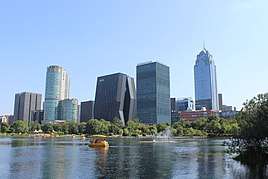


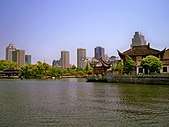

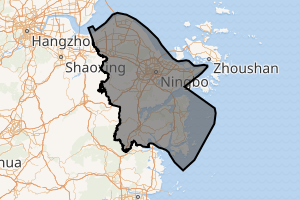
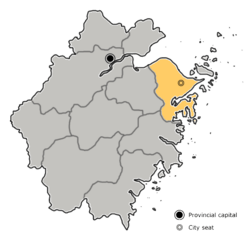
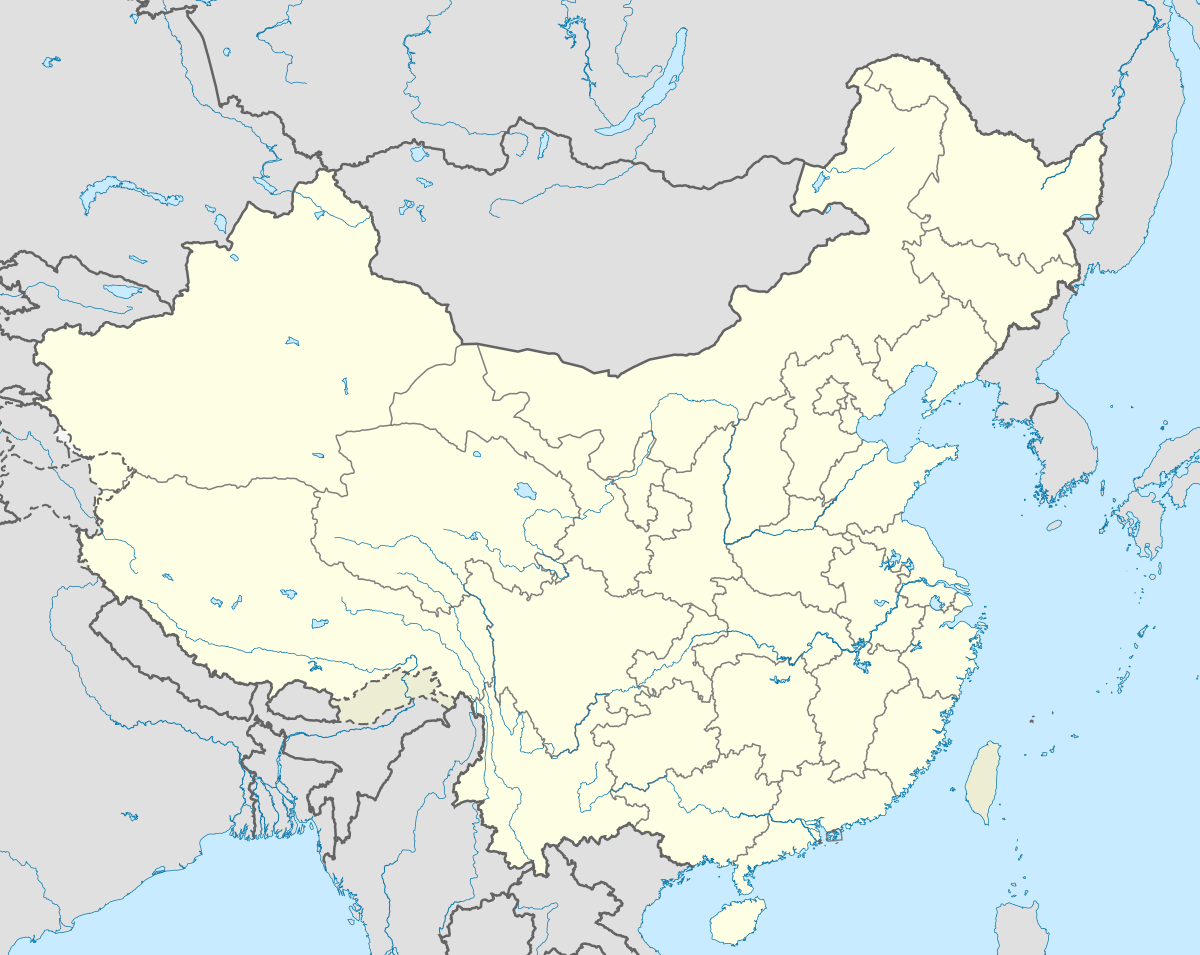
.svg.png)
